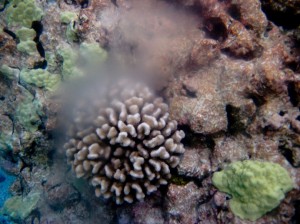Cauliflower Coral Spawning Documented for First Time
By Wendy Osher

Spawning cauliflower coral (Pocillopora meandrina) within the Shark Island lagoon, French Frigate Shoals, part of the Hawaiian Islands National Wildlife Refuge and the Papahanaumokuakea Marine National Monument. Image credit: Kristina Dickson/ USFWS
For the first time ever, the spawning of cauliflower coral (Pocillopora meandrina) has been captured on video and in photographs in the Northwestern Hawaiian Islands. While the coral is a common reef building species found throughout the Hawaiian Islands, its spawning had never before been documented in the Northwestern Hawaiian Islands.
Crews from the Fish and Wildlife Service documented the event while diving at the French Frigate Shoals in the area of Shark Island, located about 500 miles northwest of O’ahu. The waters are within the Northwestern Hawaiian Islands in the Papahānaumokuākea Marine National Monument.
“The spawning event was spectacular!” [View VIDEO of the spawning event], reports Fish and Wildlife Service volunteer Lindsey Kramer. According to Kramer, one or two colonies would begin to spawn, and the neighboring colonies would follow. The event spanned the lagoon with smoke-like puffs of reproductive materials being ejected from the coral, and washed into the out-going tide.
The first spawning activity was observed on May 19, when observers monitored 50 coral colonies, and approximately 30% of the observed colonies spawn in a matter of minutes. On May 20, observers monitored 70 coral colonies, and 95% of the observed colonies spawn in less than 15 minutes.
While significant coral research has been conducted in the Northwestern Hawaiian Islands in the past decade, the remoteness of the Monument and the difficulty in predicting the pattern and timing of coral reproduction, have made this the first documented spawning event for this species of coral.
“Most species of corals that spawn reproductive material only do so once a year, so documenting that window of time is important for understanding the species’ potential vulnerability to environmental disturbance,” said Dr. Jean Kenyon, a biologist with the FWS’ Hawaiian & Pacific Islands National Wildlife Refuge Complex.
Coral reef health is used as an indicator of how well the larger ecosystem is faring. By knowing where and when coral reproductive processes take place, reef managers are able to minimize human interference and better understand its role in the ecosystem.
*** Supporting information courtesy USFWS.










